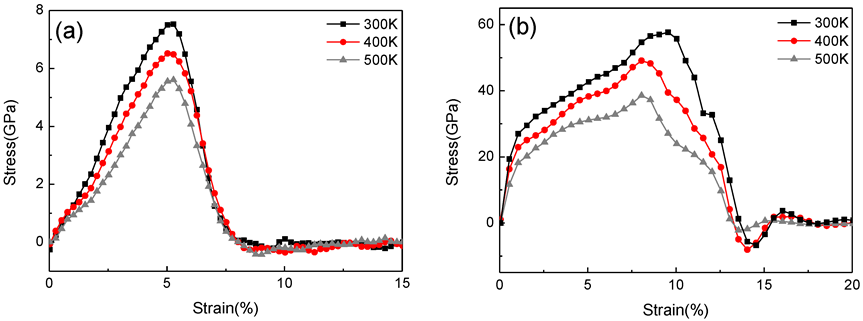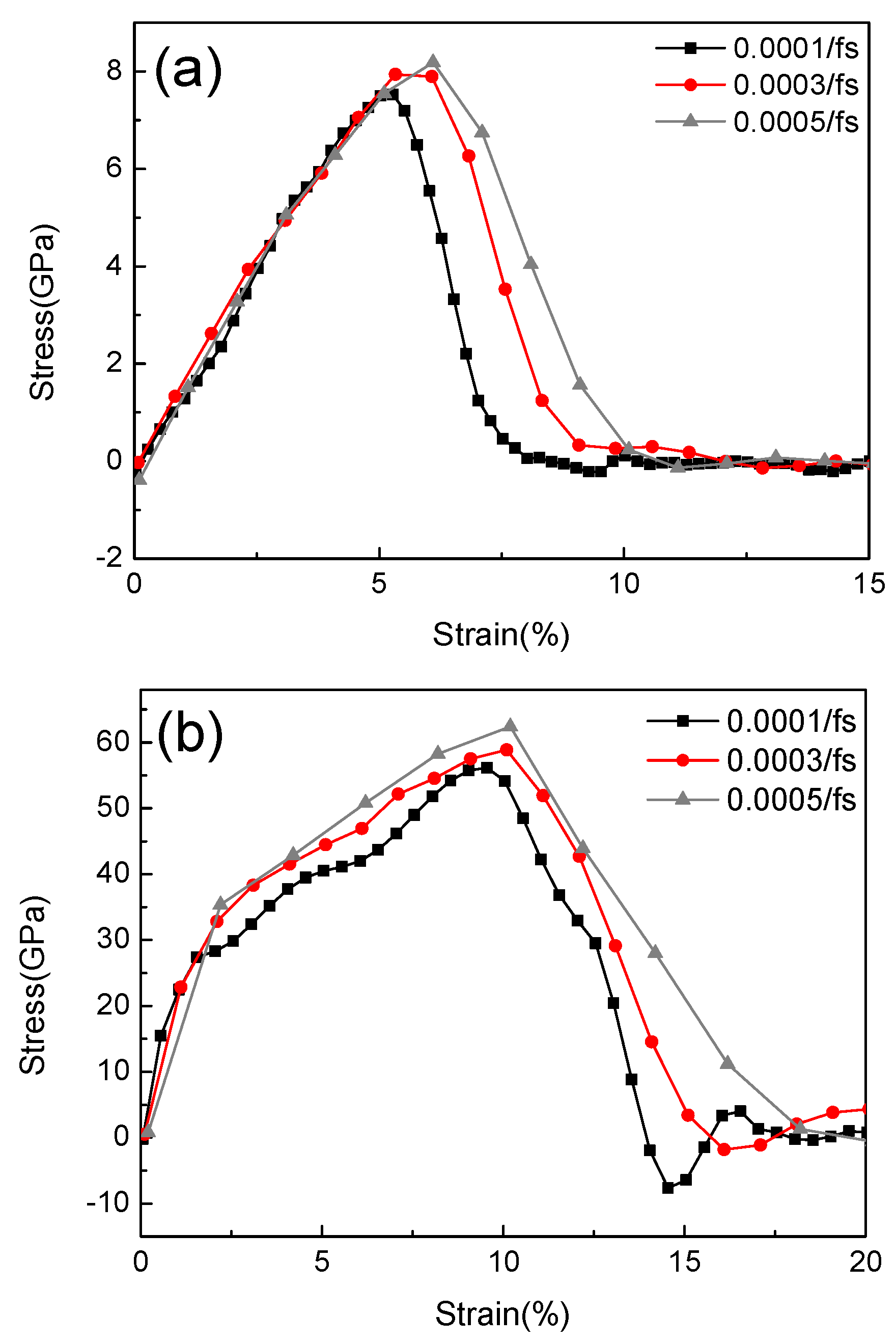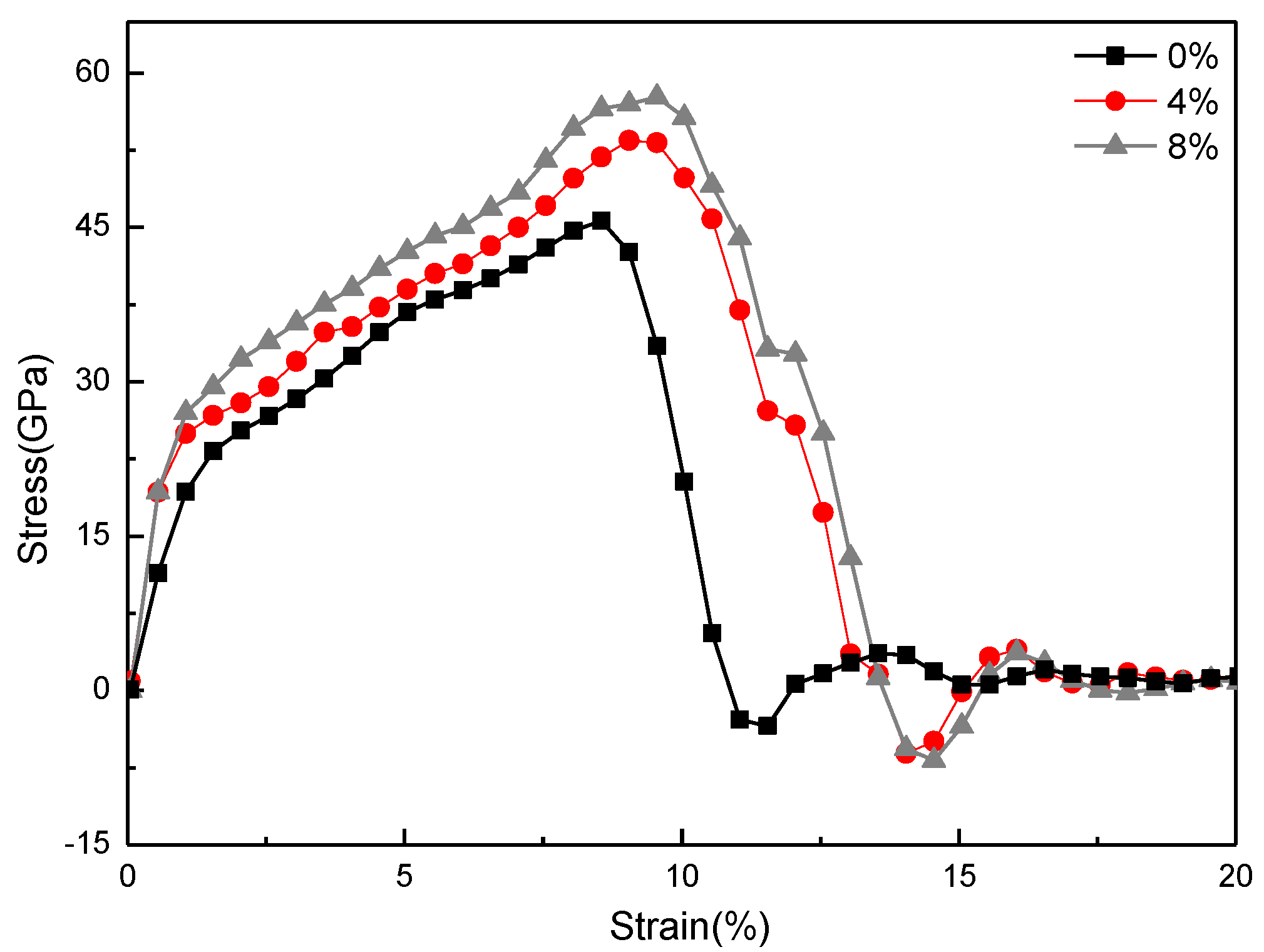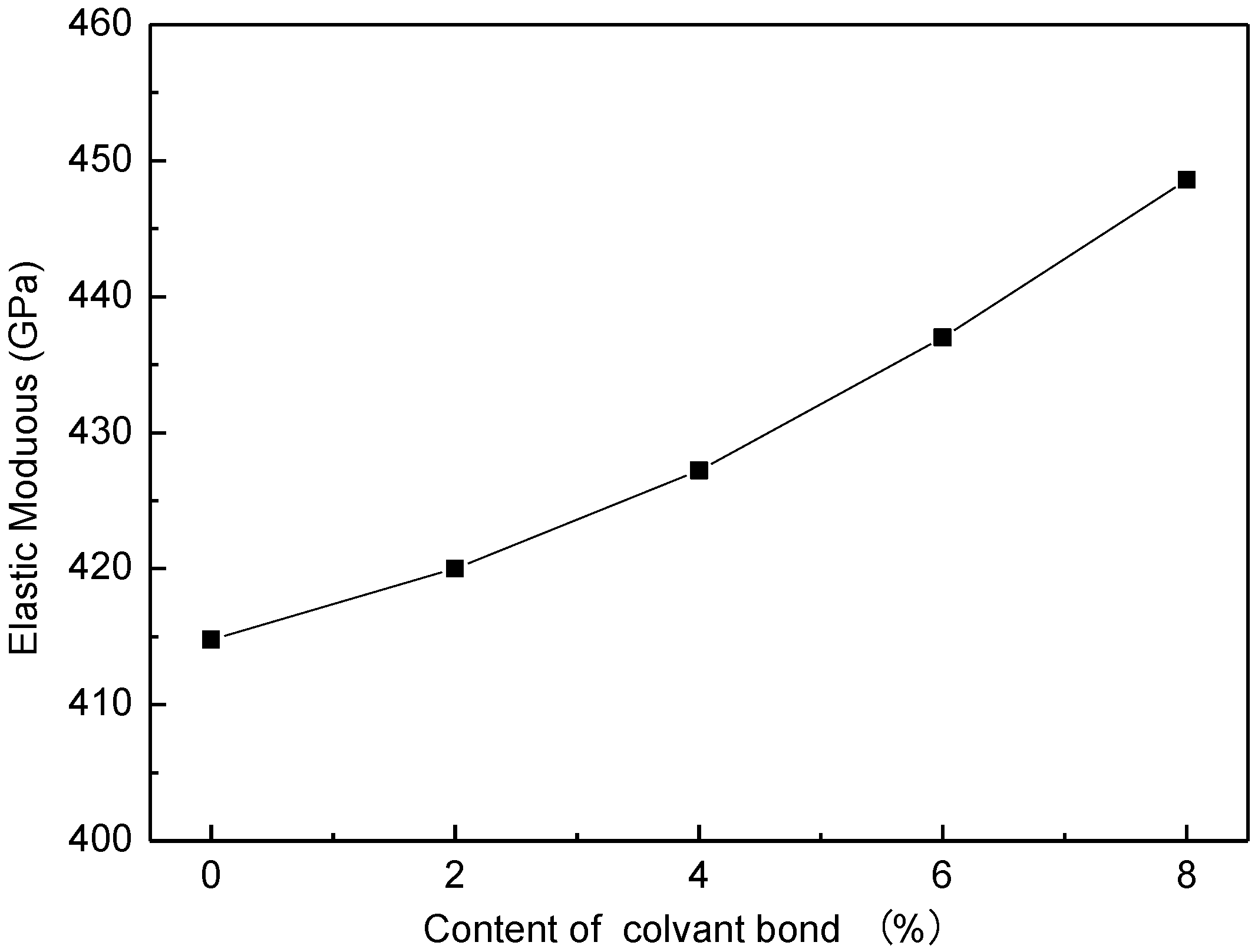Molecular Dynamics Simulations of the Mechanical Properties of Cellulose Nanocrystals—Graphene Layered Nanocomposites
Abstract
:1. Introduction
2. Models and Simulation Method
3. Results and Discussion
3.1. Effect of Temperature on Mechanical Property
3.2. Effect of Strain Rate on Mechanical Property
3.3. Effect of Covalent Bond Coverage on Mechanical Property
4. Conclusions
Author Contributions
Funding
Data Availability Statement
Conflicts of Interest
References
- Lee, Y.; Zhang, H.; Yu, H.; Tam, K.C. Electroconductive cellulose nanocrystals-synthesis properties and applications: A review. Carbohydr. Polym. 2022, 289, 119419. [Google Scholar] [CrossRef] [PubMed]
- Aziz, T.; Fan, H.; Zhang, X.; Haq, F.; Ullah, A.; Ullah, R.; Khan, F.U.; Iqbal, M. Advance Study of Cellulose Nanocrystals Properties and Application. J. Polym. Environ. 2020, 28, 1117–1128. [Google Scholar] [CrossRef]
- Torlopov, M.A.; Drozd, N.N.; Paderin, N.M.; Tarabukin, D.V.; Udoratin, E.V. Hemocompatibility, biodegradability and acute toxicity of acetylated cellulose nanocrystals of different types in comparison. Carbohydr. Polym. 2021, 269, 118307. [Google Scholar] [CrossRef] [PubMed]
- Rana, A.K.; Frollini, E.; Thakur, V.K. Cellulose nanocrystals: Pretreatments, preparation strategies, and surface functionalization. Int. J. Biol. Macromol. 2021, 182, 1554–1581. [Google Scholar] [CrossRef] [PubMed]
- Islam, K.; Saha, S.; Masud, A.K.M. Molecular dynamics simulation of the mechanical properties of CNT-polyoxymethylene composite with a reactive forcefield. Mol. Simul. 2022, 4, 80–387. [Google Scholar] [CrossRef]
- Mishnaevsky, L.; Mikkelsen, L.P.; Gaduan, A.N.; Lee, K.; Madsen, B. Nanocellulose reinforced polymer composites: Computational analysis of structure-mechanical properties relationships. Compos. Struct. 2019, 224, 111024. [Google Scholar] [CrossRef]
- Chanda, S.; Bajwa, D.S.; Holt, G.A.; Stark, N.; Bajwa, S.G.; Quadir, M. Silane compatibilzation to improve the dispersion, thermal and mechancial properties of cellulose nanocrystals in poly (ethylene oxide). Nanocomposites 2021, 7, 87–96. [Google Scholar] [CrossRef]
- Li, J.; Wu, D. Nucleation roles of cellulose nanocrystals and chitin nanocrystals in poly (ε-caprolactone) nanocomposites. Int. J. Biol. Macromol. 2022, 205, 87–594. [Google Scholar] [CrossRef] [PubMed]
- Wohlhauser, S.; Kuhnt, T.; Meesorn, W.; Espinosa, L.; Zoppe, J.O.; Weder, C. One-component nanocomposites based on polymer-grafted cellulose nanocrystals. Macromolecules 2020, 53, 821–834. [Google Scholar] [CrossRef]
- Tian, D.; Wang, F.; Yang, Z.; Niu, X.; Wu, Q.; Sun, P. High-performance polyurethane nanocomposites based on UPy-modified cellulose nanocrystals. Carbohydr. Polym. 2019, 219, 191–200. [Google Scholar] [CrossRef] [PubMed]
- Dias, O.A.T.; Konar, S.; Pakharenko, V.; Graziano, A.; Leão, A.L.; Tjong, J.; Jaffer, S.; Cui, T.; Filleter, T.; Sain, M. Molecular design and structural optimization of nanocellulose-based films fabricated via regioselective functionalization for flexible electronics. Chem. Eng. J. 2022, 440, 135950. [Google Scholar] [CrossRef]
- Badkoobehhezaveh, A.M.; Hopmann, E.; Elezzabi, A.Y. Flexible multicolor electroluminescent devices on cellulose nanocrystal platform. Adv. Eng. Mater. 2020, 22, 1901452. [Google Scholar] [CrossRef]
- Gonçalves, R.; Lizundia, E.; Silva, M.M.; Costa, C.M.; Lanceros-Méndez, S. Mesoporous cellulose nanocrystal membranes as battery separators for environmentally safer lithium-ion batteries. ACS. Appl. Energy Mater. 2019, 2, 3749–3761. [Google Scholar] [CrossRef]
- Kim, K.; Kim, P.J.; Chowdhury, R.A.; Kantharaj, R.; Candadai, A.; Marconnet, A.; Pol, V.G.; Youngblood, J.P. Structural orientation effect of cellulose nanocrystals (CNC) films on electrochemical kinetics and stability in lithium-ion batteries. Chem. Eng. J. 2021, 417, 128128. [Google Scholar] [CrossRef]
- Ajkidkarn, P.; Manuspiya, H. Novel bacterial cellulose nanocrystals/polyether block amide microporous membranes as separators for lithium-ion batteries. Int. J. Biol. Macromol. 2020, 164, 3580–3588. [Google Scholar] [CrossRef] [PubMed]
- Zhao, Q.; Meng, X.; Li, Y.; Peng, H.; Whittaker, A.K.; Zhu, S. Ultrasensitive magnetic tuning of optical properties of films of cholesteric cellulose nanocrystals. ACS Nano 2020, 14, 9440–9448. [Google Scholar] [CrossRef]
- Zhang, F.; Ge, W.; Wang, C.; Zheng, X.; Wang, D.; Zhang, X.; Wang, X.; Xue, X.; Qing, G. Highly strong and solvent-resistant cellulose nanocrystal photonic films for optical coatings. ACS Appl. Mater. Interfaces 2021, 13, 17118–17128. [Google Scholar] [CrossRef]
- Wu, X.; Moon, R.J.; Martini, A. Tensile strength of Iβ crystalline cellulose predicted by molecular dynamics simulation. Cellulose 2014, 21, 2233–2245. [Google Scholar] [CrossRef]
- Dri, F.L.; Hector, L.G., Jr.; Moon, R.J.; Zavattieri, P.D. Anisotropy of the elastic properties of crystalline cellulose Iβ from first principles density functional theory with Van der Waals interactions. Cellulose 2013, 20, 2703–2718. [Google Scholar] [CrossRef]
- Ogawa, Y.; Nishiyama, Y.; Mazeau, K. Drying-induced bending deformation of cellulose nanocrystals studied by molecular dynamics simulations. Cellulose 2020, 27, 9779–9786. [Google Scholar] [CrossRef]
- Wei, Z.; Sinko, R.; Keten, S.; Luijten, E. Effect of surface modification on water adsorption and interfacial mechanics of cellulose nanocrystals. ACS Appl. Mater. Interfaces 2018, 10, 8349–8358. [Google Scholar] [CrossRef] [PubMed]
- Wu, X.; Moon, R.J.; Martini, A. Crystalline cellulose elastic modulus predicted by atomistic models of uniform deformation and nanoscale indentation. Cellulose 2014, 20, 43–55. [Google Scholar] [CrossRef]
- Gicquel, E.; Martin, C.; Yanez, J.G.; Bras, J. Cellulose nanocrystals as new biobased coating layer for improving fiber-based mechanical and barrier properties. J. Mater. Sci. 2016, 52, 3048–3061. [Google Scholar] [CrossRef]
- Cheng, Q.; Ye, D.; Chang, C.; Zhang, L. Facile fabrication of superhydrophilic membranes consisted of fibrous tunicate cellulose nanocrystals for highly efficient oil/water separation. J. Membr. Sci. 2017, 525, 1–8. [Google Scholar] [CrossRef]
- Liu, P.; Guo, X.; Nan, F.; Duan, Y.; Zhang, J. Modifying mechanical, optical properties and thermal processability of iridescent cellulose nanocrystal films using ionic liquid. ACS Appl. Mater. Interfaces 2017, 9, 3085–3092. [Google Scholar] [CrossRef]
- Haywood, A.D.; Davis, V.A. Effects of liquid crystalline and shear alignment on the optical properties of cellulose nanocrystal films. Cellulose 2016, 24, 705–716. [Google Scholar] [CrossRef]
- Mu, X.; Gray, D.G. Formation of chiral nematic films from cellulose nanocrystal suspensions is a two-stage process. Langmuir 2014, 30, 9256–9260. [Google Scholar] [CrossRef]
- Kose, O.; Tran, A.; Lewis, L.; Hamad, W.Y.; MacLachlan, M.J. Unwinding a spiral of cellulose nanocrystals for stimuli-responsive stretchable optics. Nat. Commun. 2019, 10, 510. [Google Scholar] [CrossRef] [PubMed] [Green Version]
- Mattsson, T.R.; Lane, J.M.D.; Cochrane, K.R.; Desjarlais, M.P.; Thompson, A.P.; Pierce, F.; Grest, G.S. First-principles and classical molecular dynamics simulation of shocked polymers. Phys. Rev. B 2010, 81, 054103. [Google Scholar] [CrossRef]
- Federica, C.; Marras, E.; Giorcelli, M.; Jagdale, P.; Lavagna, L.; Tagliaferro, A.; Bartoli, M. A review on recent advancements of graphene and graphene-related materials in biological applications. Appl. Sci. 2022, 11, 614. [Google Scholar] [CrossRef]
- Gong, S.; Ni, H.; Jiang, L.; Cheng, Q. Learning from nature: Constructing high performance graphene-based nanocomposites. Mater. Today 2017, 20, 210–219. [Google Scholar] [CrossRef]
- Papageorgiou, D.G.; Kinloch, I.A.; Young, R.J. Mechanical properties of graphene and graphene-based nanocomposites. Prog. Mater. Sci. 2017, 90, 75–127. [Google Scholar] [CrossRef]
- Zhang, M.; Huang, L.; Chen, J.; Li, C.; Shi, G. Ultratough, Ultrastrong, and Highly Conductive Graphene Films with Arbitrary Sizes. Adv. Mater. 2014, 26, 7588–7592. [Google Scholar] [CrossRef] [PubMed]
- Cheng, Q.; Jiang, L.; Tang, Z. Bioinspired Layered Materials with Superior Mechanical Performance. Acc. Chem. Res. 2014, 47, 1256–1266. [Google Scholar] [CrossRef] [PubMed]
- Park, S.; Dikin, D.A.; Nguyen, S.T.; Ruoff, R.S. Graphene oxide sheets chemically cross-linked by polyallylamine. J. Phys. Chem. C 2009, 113, 15801–15804. [Google Scholar] [CrossRef]
- Tian, Y.; Cao, Y.; Wang, Y.; Yang, W.; Feng, J. Realizing ultrahigh modulus and high strength of macroscopic graphene oxide papers through crosslinking of mussel-inspired polymers. Adv. Mater. 2013, 25, 2980–2983. [Google Scholar] [CrossRef] [PubMed]
- Plimpton, S. Fast Parallel algorithms for short-range molecular dynamics. J. Comput. Phys. 1995, 117, 1–19. [Google Scholar] [CrossRef] [Green Version]
- Delacruz, J.A.; Liu, Q.; Senyuk, B.; Frazier, A.W.; Peddireddy, K.; Smalyukh, I.I. Cellulose-based reflective liquid crystal films as optical filters and solar gain regulator. ACS Photonics 2018, 5, 2468–2477. [Google Scholar] [CrossRef]
- Dong, R.Y.; Dong, Y.; Li, Q.; Wan, C. Ballistic-diffusive phonon transport in cellulose nanocrystals by ReaxFF molecular dynamics simulations. Int. J. Heat Mass Transf. 2020, 148, 119155. [Google Scholar] [CrossRef]
- Vlassiouk, I.; Polizos, G.; Cooper, R.; Ivanov, I.; Keum, J.K.; Paulauskas, F.; Datskos, P.; Smirnov, S. Strong and electrically conductive graphene-based composite fibers and laminates. ACS Appl. Mater. Inter. 2015, 7, 10702–11070. [Google Scholar] [CrossRef]
- Shishehbor, M.; Pouranian, M.R. Tuning the mechanical and adhesion properties of carbon nanotubes using aligned cellulose wrap (Cellulose Nanotube): A Molecular Dynamics Study. Nanomaterials 2020, 10, 154. [Google Scholar] [CrossRef] [PubMed] [Green Version]
- Araujo, C.; Freire, C.S.R.; Nolasco, M.M.; Ribeiro-Claro, P.J.A.; Rudić, S.; Silvestre, A.J.D.; Vaz, P.D. Hydrogen bond dynamics of cellulose through inelastic neutron scattering spectroscopy. Biomacromolecules 2018, 19, 1305–1313. [Google Scholar] [CrossRef] [PubMed]
- Young, R.J.; Liu, M.; Kinloch, I.A.; Li, S.; Zhao, X.; Vallés, C.; Papageorgioul, D.G. The mechanics of reinforcement of polymers by graphene nanoplatelets. Compos. Sci. Technol. 2018, 154, 110–116. [Google Scholar] [CrossRef]









Publisher’s Note: MDPI stays neutral with regard to jurisdictional claims in published maps and institutional affiliations. |
© 2022 by the authors. Licensee MDPI, Basel, Switzerland. This article is an open access article distributed under the terms and conditions of the Creative Commons Attribution (CC BY) license (https://creativecommons.org/licenses/by/4.0/).
Share and Cite
Zhang, X.; Chen, Z.; Lu, L.; Wang, J. Molecular Dynamics Simulations of the Mechanical Properties of Cellulose Nanocrystals—Graphene Layered Nanocomposites. Nanomaterials 2022, 12, 4170. https://doi.org/10.3390/nano12234170
Zhang X, Chen Z, Lu L, Wang J. Molecular Dynamics Simulations of the Mechanical Properties of Cellulose Nanocrystals—Graphene Layered Nanocomposites. Nanomaterials. 2022; 12(23):4170. https://doi.org/10.3390/nano12234170
Chicago/Turabian StyleZhang, Xingli, Zhiyue Chen, Liyan Lu, and Jiankai Wang. 2022. "Molecular Dynamics Simulations of the Mechanical Properties of Cellulose Nanocrystals—Graphene Layered Nanocomposites" Nanomaterials 12, no. 23: 4170. https://doi.org/10.3390/nano12234170




